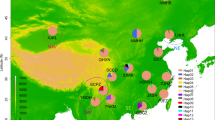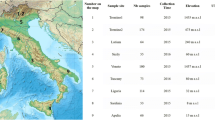Abstract
Drosophila sechellia is closely related to the cosmopolitan and widespread model species, D. simulans. This species, endemic to the Seychelles archipelago, is specialized on the fruits of Morinda citrifolia, and harbours the lowest overall genetic diversity compared to other species of Drosophila. This low diversity is associated with a small population size. In addition, no obvious population structure has been evidenced so far across islands of the Seychelles archipelago. Here, a microsatellite panel of 17 loci in ten populations from nine islands of the Seychelles was used to assess the effect of the D. sechellia’s fragmented distribution on the fine-scale population genetic structure, the migration pattern, as well as on the demography of the species. Contrary to previous results, also based on microsatellites, no evidence for population contraction in D. sechellia was found. The results confirm previous studies based on gene sequence polymorphism that showed a long-term stable population size for this species. Interestingly, a pattern of Isolation By Distance which had not been described yet in D. sechellia was found, with evidence of first-generation migrants between some neighbouring islands. Bayesian structuring algorithm results were consistent with a split of D. sechellia into two main groups of populations: Silhouette/Mahé versus all the other islands. Thus, microsatellites suggest that variability in D. sechellia is most likely explained by local genetic exchanges between neighbouring islands that have recently resulted in slight differentiation of the two largest island populations from all the others.



Similar content being viewed by others
References
Amlou M, Moreteau B, David JR (1998) Larval tolerance in the Drosophila melanogaster species complex toward the two toxic acids of the D. sechellia host plant. Hereditas 129:7–14
Andolfatto P (2001) Contrasting patterns of nucleotide variation at X-linked and autosomal loci in Drosophila melanogaster and D. simulans. Mol Biol Evol 18:275–290
Begun DJ, Whitley P (2000) Reduced X-linked nucleotide polymorphism in Drosophila simulans. Proc Natl Acad Sci USA 97:5960–5965
Benjamini Y, Yekutieli D (2001) The control of false discovery rate under dependency. Ann Stat 29:1165–1188
Bilgin R (2007) Kgtests: a simple excel macro program to detect signatures of population expansion using microsatellites. Mol Ecol Notes 7:416–417
Cariou M-L, Solignac M, Monnerot M, David JR (1990) Low allozyme and mtDNA variability in the island endemic species Drosophila sechellia (D. melanogaster complex). Experientia 46:101–104
Cobb M, Huet M, Lachaise D, Veuille M (2001) Fragmented forests, evolving flies: molecular variation in African populations of Drosophila teissieri. Mol Ecol 9:1591–1597
Colson I, Goldstein DB (1999) Evidence for complex mutations at microsatellite loci in Drosophila. Genetics 152:617–627
Colson I, MacDonald SJ, Goldstein DB (1999) Microsatellite markers for interspecific mapping of Drosophila simulans and D. sechellia. Mol Ecol 8:1951–1955
Cornuet J-M, Luikart G (1996) Description and power analysis of two tests for detecting recent bottlenecks from allele frequency data. Genetics 144:2001–2014
Dekker T, Ibba I, Siju KP, Stensmyr MC, Hansson BS (2006) Olfactory shifts parallel superspecialism for toxic fruit in Drosophila melanogaster sibling, D. sechellia. Curr Biol 16:101–109
Dieringer D, Schlötterer C (2003) Microsatellite analyser (MSA): a platform independent analysis tool for large microsatellite data sets. Mol Ecol Notes 3:167–169
Dobzhansky T, Powell JR (1974) Rates of dispersal of Drosophila pseudoobscura and its relatives. Proc R Soc Lond B Biol Sci 187:281–298
Dworkin I, Jones CD (2009) Genetic changes accompagnying the evolution of host specialization in Drosophila sechellia. Genetics 181:721–736
Evanno G, Regnaut S, Goudet J (2005) Detecting the number of clusters of individuals using the software STRUCTURE: a simulation study. Mol Ecol 14:2611–2620
Excoffier L, Laval G, Schneider S (2005) ARLEQUIN (version 3.0): an integrated software package for population genetics data analysis. Evol Bioinf Online 1:47–50
Garza JC, Williamson EG (2001) Detection of reduction in population size using data from microsatellite loci. Mol Ecol 10:305–318
Glaubitz JC (2004) CONVERT: a user friendly program to reformat diploid genotypic data for commonly used population genetic software packages. Mol Ecol Notes 4:309–310
Goldstein DB, Clark AG (1995) Microsatellite variation in North American populations of Drosophila melanogaster. Nucleic Acids Res 23:3882–3886
Goudet J (2001) FSTAT, a program to estimate and test gene diversities and fixation indices (version 2.9.3). http://www.unil2.ch/genpop/softwares/fstat.html
Harr B, Schlötterer C (2004) Patterns of microsatellite variability in the Drosophila melanogaster complex. Genetica 120:71–77
Hutter CM, Schug MD, Aquadro CF (1998) Molecular variation in Drosophila melanogaster and Drosophila simulans: a reciprocal test of the ascertainment bias hypothesis. Mol Biol Evol 15:1620–1636
Jones CD (2005) The genetics of adaptation in Drosophila sechellia. Genetica 123:137–145
Kliman RM, Andolfatto P, Coyne JA, Depaulis F, Kreitman M, Berry AJ, McCarter J, Wakeley J, Hey J (2000) The population genetics of the origin and divergence of the Drosophila simulans complex species. Genetics 156:1913–1931
Kopp A, Barmina O, Hamilton AM, Higgins L, McIntyre LM, Jones CD (2008) Evolution of gene expression in the Drosophila olfactory system. Mol Biol Evol 25:1081–1092
Lachaise D, Silvain J-F (2004) How two Afrotropical endemics made two cosmopolitan human commensals: the Drosophila melanogaster-D. simulans paleogeographic riddle. Genetica 120:17–39
Lachaise D, Cariou ML, David JR, Lemeunier F, Tsacas L, Ashburner M (1988) Historical biogeography of the Drosophila melanogaster species subgroup. Evol Biol 22:159–225
Lachaise D, Capy P, Cariou ML, Joly D, Lemeunier F, David JR (2004) Nine relatives from one African ancestor: population biology and evolution of the Drosophila melanogaster subgroup species. In: Singh RS, Uyenoyama MK (eds) The evolution of population biology. Cambridge University Press, Cambridge, pp 315–343
Legrand D, Tenaillon MI, Matyot P, Gerlach J, Lachaise D, Cariou M-L (2009) Species-wide genetic variation and demographic history of Drosophila sechellia, a species lacking population structure. Genetics 182:1197–1206
Legrand D, Chenel T, Campagne C, Lachaise D, Cariou M-L (2011) Inter-island divergence within Drosophila mauritiana, a species of the D. simulans complex: past history and/or speciation in progress? Mol Ecol 20:2787–2804
Louis J, David JR (1986) Ecological specialization in the Drosophila melanogaster species subgroup: a case study of D. sechellia. Acta Oecol 7:215–229
Luikart G, Cornuet J-M, Allendorf FW, Sherwin WB (1998) Distortion of allele frequency distributions provides a test for recent population bottlenecks. J Hered 89:238–247
Mallet J (2006) What does Drosophila genetics tell us about speciation? Trends Ecol Evol 21:386–393
Matsuo T, Sugaya S, Yasukawa J, Aigaki T, Fuyama Y (2007) Odorant-binding proteins OBP57d and OBP57e affect taste perception and host-plant preference in Drosophila sechellia. PLoS Biol 5:e118
McBride CS (2007) Rapid evolution of smell and taste receptor genes during host specialization in Drosophila sechellia. Proc Natl Acad Sci USA 104:4996–5001
Nielsen R, Beaumont MA (2009) Statistical inferences in phylogeography. Mol Ecol 18:1034–1047
Nunes MDS, Neumeier H, Schlötterer C (2008) Contrasting patterns of natural variation in global Drosophila melanogaster populations. Mol Ecol 17:4470–4479
Paetkau D, Calvert W, Stirling I, Strobeck C (1995) Microsatellite analysis of population structure in Canadian polar bears. Mol Ecol 4:347–354
Paetkau D, Slade R, Burden M, Estoup A (2004) Direct, real-time estimation of migration rate using assignment methods: a simulation-based exploration of accuracy and power. Mol Ecol 13:55–65
Piry S, Alapetite A, Cornuet J-M, Paetkau D, Baudouin L, Estoup A (2004) GENEClASS2: a software for genetic assignment and first-generation migrant detection. J Hered 95:536–539
Pritchard JK, Stephens M, Donnelly P (2000) Inference of population structure using multilocus genotype data. Genetics 155:945–959
Rannala B, Mountain JL (1997) Detecting immigration by using multilocus genotypes. Proc Natl Acad Sci USA 94:9197–9201
Raymond M, Rousset F (1995) GENEPOP (version 1.2): population genetics software for exact tests and ecumenicism. J Heredity 86:248–249
Reich DE, Goldstein DB (1998) Genetic evidence for a Paleolithic human population expansion in Africa. Proc Natl Acad Sci USA 95:8119–8123
Reich DE, Feldman MW, Goldstein DB (1999) Statistical properties of two tests that use multilocus data sets to detect population expansion. Mol Biol Evol 16:453–466
R’kha S, Capy P, David JR (1991) Host-plant specialization in the Drosophila melanogaster species complex: a physiological, behavioral, and genetical analysis. Proc Natl Acad Sci USA 88:1835–1839
Rogers A, Harpending H (1992) Population growth makes waves in the distribution of pairwise genetic differences. Mol Biol Evol 9:552–569
Roose-Amsaleg C, Cariou-Pham E, Vautrin D, Tavernier R, Solignac M (2006) Polymorphic microsatellite loci in Linum usitatissimum. Mol Ecol Notes 6:796–799
Rousset F (1997) Genetic differentiation and estimation of gene flow from F-statistics under isolation by distance. Genetics 145:1219–1228
Schöfl G, Schlötterer C (2006) Microsatellite variation and differentiation in African and non-African populations of Drosophila simulans. Mol Ecol 15:3895–3905
Schug MD, Mackay TF, Aquadro CF (1997) Low mutation rates of microsatellite loci in Drosophila melanogaster. Nature Rev Genet 15:99–102
Solignac M (2004) Mitochondrial DNA in the Drosophila melanogaster complex. Genetica 120:41–50
Tsacas L, Bächli G (1981) Drosophila sechellia, n.sp., huitième espèce du sous-groupe melanogaster des Iles Séchelles [Diptera, Drosophilidae]. Revue Fr Ent NS 3:146–150
Van Oosterhout C, Hutchinson WF, Wills DPM, Shipley P (2004) MICRO-CHECKER: software for identifying and correcting genotyping errors in microsatellite data. Mol Ecol Notes 4:535–538
Weir BS, Cockerham CC (1984) Estimating F-Statistics for the analysis of population structure. Evolution 38:1358–1370
Zhang DX, Hewitt GM (2003) Nuclear DNA analyses in genetic studies of populations: practice, problems and prospects. Mol Ecol 12:563–584
Acknowledgments
We thank the two reviewers for helpful comments and valuable suggestions. We thank Jean-Luc Da Lage for analyzing the data with M_P_VAL.EXE software and Emilie Robillard for formatting the data. This work was funded by the French Ministry of Environment and Sustainable Development through the programme “Invasions Biologiques” (CV 02000216), by the Centre National de la Recherche Scientifique and by the ANR Biodiversity program (ANR-06-BDIV-002-05).
Author information
Authors and Affiliations
Corresponding author
Additional information
Daniel Lachaise deceased in 2006.
Electronic supplementary material
Below is the link to the electronic supplementary material.
10709_2011_9595_MOESM1_ESM.docx
Figure S1: Determination of the number of clusters best fitting allele frequencies at 17 microsatellites in D. sechellia. (above): Mean log-likelihood over five runs for K comprised between 1 and 10, (below): ΔK as a function of K following Evanno et al. (2005)
Rights and permissions
About this article
Cite this article
Legrand, D., Vautrin, D., Lachaise, D. et al. Microsatellite variation suggests a recent fine-scale population structure of Drosophila sechellia, a species endemic of the Seychelles archipelago. Genetica 139, 909–919 (2011). https://doi.org/10.1007/s10709-011-9595-8
Received:
Accepted:
Published:
Issue Date:
DOI: https://doi.org/10.1007/s10709-011-9595-8




